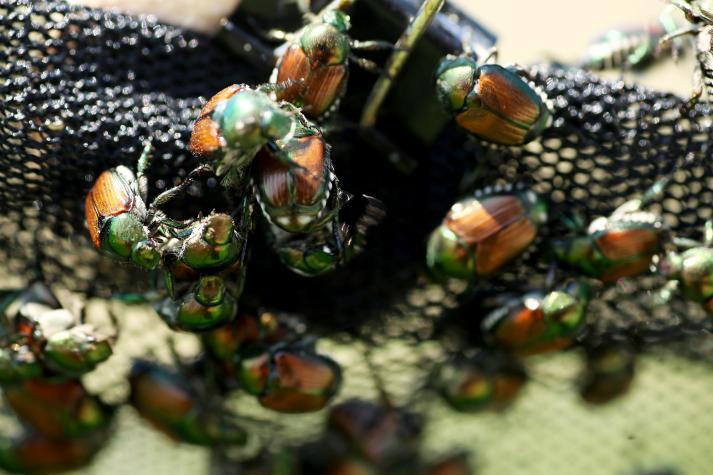Writer
Linda GeistCOLUMBIA, Mo. – Japanese beetles—those mean, green eating machines—are peaking throughout much of Missouri.
University of Missouri Extension field crops entomologist Kevin Rice hopes his research on Japanese beetles will take a bite out of their buffet.
Japanese beetles cause large economic losses for the agricultural community. Adult beetles typically feed on silks and tassels in corn and foliage on soybean. They also damage the foliage and fruit of more than 400 flower, shrub and tree species.
Currently, pyrethroids are the best knockdown control measure for them, says Rice. Apply chemical control when thresholds are met. The beetles move quickly from nearby woods, fields and lawns to re-infest an area, so multiple applications might be necessary.
Rice and his team of MU graduate students are researching the use of nets containing pyrethroids to control Japanese beetles. They place nets and pheromone lures around field borders. Previous researchers found that beetles pick up a toxic dose within three seconds. The nets remain effective throughout the growing season and are unlikely to attract pollinators.
“It’s not a silver bullet,” Rice says, “but it’s a bullet.”
Japanese beetles are in peak season in Missouri now. Rice recommends chemical control when economic thresholds are reached. Bags and traps are far less effective and may attract more beetles.
Traps catch about 75 percent of beetles and can actually attract more beetles than they capture, according to the USDA publication “Managing the Japanese Beetle: A Homeowner’s Handbook” (bit.ly/2KJsCdo).
If you use traps, place them away from plants and on the borders of yards or fields.
Rice says his research is in the preliminary stages and he does not recommend nets yet. He says homeowners and farmers should continue to monitor lawns and fields. Apply chemicals in a timely manner according to label instructions.
The adult Japanese beetle is a little less than half an inch long and has a shiny, metallic-green body with bronze-colored outer wings. The beetle has six tufts of white hair under the edges of its wings. Japanese beetles produce one generation each year and can burrow up to 12 inches below soil in the winter to survive.
You can monitor Japanese beetles and other pests at MU’s Integrated Pest Management website, ipm.missouri.edu/pestMonitoring/jb.
Photos available for this release:
https://extension.missouri.edu/media/wysiwyg/Extensiondata/NewsAdmin/Photos/stock/bugs/JapaneseBeetles.jpg
University of Missouri Extension entomologist Kevin Rice and his team of graduate students research the use of pyrethroid nets to control foliage-eating Japanese beetles. Photo by Jessi Dodge, MU Extension.
